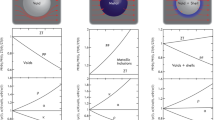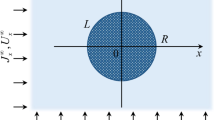Abstract
Modulation doping has recently emerged as a method for improving the thermoelectric figure of merit using composite materials. By spatially decoupling charge carriers from their dopant impurities, the average carrier mobility can be improved by reducing the influence of ionized impurity scattering. However, as we show in the present work using a simple parabolic band model and effective medium approach, enhancement in such composites is effective only if ionized impurities dominate the scattering of the charge carriers, which is often not the case in many materials. For example, the enhancement is more significant at lower temperatures (T < 300 K for our model material) where acoustic phonon scattering begins to freeze out. Furthermore, for large dielectric constant, which is common for good thermoelectric materials, the ionized impurities are largely screened, and formation of the modulation-doped composite is likely to have little to no benefit, or possibly even degrade the thermoelectric performance of the material. The effective mass of the charge carriers also plays an important role in the relative strength of the scattering mechanism and the possibility for thermoelectric enhancement through modulation doping.






Similar content being viewed by others
References
G.S. Nolas, J. Sharp, H.J. Goldsmid, Thermoelectrics: Basic Principles and New Materials Developments (Springer, Berlin, 2001)
A.F. Ioffe, Semiconductor Thermoelements and Thermoelectric Cooling (Infosearch Ltd, London, 1957)
D. Beretta, N. Neophytou, J. M. Hodges, M. Kanatzidis, D. Narducci, M. Martiin-Gonzaalez, M. Beekman, B. Balke, G. Cerritti, W. Tremel, A. Zevalkink, A. I. Hofmann, C. Müller, B. Dörling, M. Campoy-Quiles, M. Caironi, Mater. Sci. Eng. R. Reports, in press (2018). https://doi.org/10.1016/j.mser.2018.09.001
G.J. Snyder, E.S. Toberer, Nature Mater. 7, 105 (2008)
M. Beekman, D.T. Morelli, G.S. Nolas, Nature Mater. 14, 1182 (2015)
M.G. Kanatzidis, Chem. Mater. 22, 648 (2010)
J. Heremans, M.S. Dresselhaus, L.E. Bell, D.T. Morelli, Nature Nanotech. 8, 471 (2013)
A.M. Dehkordi, M. Zebarjadi, J. He, T.M. Tritt, Mater. Sci. Eng. R Rep. 97, 1 (2015)
D.J. Bergman, O. Levy, J. Appl. Phys. 70, 6821 (1991)
D.J. Bergman, L.G. Fel, J. Appl. Phys. 85, 8205 (1999)
J.P. Heremans, C.M. Jaworski, Appl. Phys. Lett. 93, 122107 (2008)
R. Dingle, H.L. Störmer, A.C. Gossard, W. Wiegmann, Appl. Phys. Lett. 33, 665 (1978)
L. Pfeiffer, K.W. West, H.L. Störmer, K.W. Baldwin, Appl. Phys. Lett. 55, 1888 (1989)
D.C. Tsui, H.L. Störmer, A.C. Gossard, Phys. Rev. Lett. 48, 1559 (1982)
L.D. Hicks, M.D. Dresselhaus, Phys. Rev. B 47, 12727 (1993)
M. Zebarjadi, G. Joshi, G. Zhu, B. Yu, A. Minnich, Y. Lan et al., Nano Lett. 11, 2225 (2011)
B. Yu, M. Zebarjadi, H. Wang, K. Lukas, H. Wang, D. Wang et al., Nano Lett. 12, 2077 (2012)
Y.-L. Pei, H. Wu, D. Wu, F. Zheng, J. He, J. Am. Chem. Soc. 136, 13902 (2014)
D. Wu, Y. Pei, Z. Wang, H. Wu, L. Huang, L.-D. Zhao et al., Adv. Funct. Mater. 24, 7763 (2014)
M. Beekman, S.R. Bauers, D.M. Hamann, D.C. Johnson, in Advanced Thermoelectric Materials, ed. by C.R. Park (Wiley, New York, 2018), pp. 1–34
Q.R. Hou, B.F. Gu, Y.B. Chen, Y.J. He, Phys. Status Solidi A. 209, 1307 (2012)
A. Samarelli, L. FerreLlin, S. Cecchi, J. Frigerio, T. Etzelstorfer, E. Müller et al., J. Appl. Phys. 113, 233704 (2013)
D. Lee, S.Y. Sayed, S. Lee, C.A. Kuryak, J. Zhou, G. Chen, Y. Shao-Horn, Nanoscale 8, 19754 (2016)
N. Neophytou, S. Foster, V. Vargiamidis, G. Pennelli, D. Narducci, Mater. Today Phys. 11, 100159 (2019)
N. Neophytou, X. Zianni, H. Kosina, S. Frabboni, B. Lorenzi, D. Narducci, Nanotechnology 24, 205402 (2013)
G.H. Döhler, J. Vac. Sci. Technol. 16, 851 (1979)
J. Bardeen, W. Shockley, Phys. Rev. 80, 72 (1950)
S.S. Li, Semiconductor Physical Electronics (Springer LLC, New York, 2006)
H. Brooks, in Advances in Electronics and Electron Physics, vol. 7, ed. by L. Marton (Academic Press, New York, 1955), pp. 85–182
Y. Gelbstein, J. Appl. Phys. 105, 023713 (2009)
Python Software Foundation. Python Programming Language, version 3.5.2. https://www.python.org [Online; accessed 2019–06–26].
E. Jones, E. Oliphant, P. Peterson, et al. SciPy: Open Source Scientific Tools for Python, 2001-. https://www.scipy.org/ [Online; accessed 2019–06–26].
Semiconductors on NSM. https://www.ioffe.ru/SVA/NSM/Semicond/. Accessed March 1, 2019.
R.P. Chasmar, R.J. Stratton, J. Electron. Control 7, 52 (1959)
Y. Pei, A.D. LaLonde, H. Wang, G.J. Snyder, Energy Env. Sci. 5, 7963 (2012)
Acknowledgements
MB, GH, and TML gratefully acknowledge support from a Cal Poly Research, Scholarly, and Creative Activities grant. MB and GH gratefully acknowledge support from the William and Linda Frost Fund. DCJ acknowledges support from the National Science Foundation under grant DMR-1710214. MB thanks M. Zebarjadi, G. J. Snyder, and M. J. Moelter for helpful discussions.
Author information
Authors and Affiliations
Corresponding author
Additional information
Publisher's Note
Springer Nature remains neutral with regard to jurisdictional claims in published maps and institutional affiliations.
Electronic supplementary material
Below is the link to the electronic supplementary material.
Rights and permissions
About this article
Cite this article
Beekman, M., Heaton, G., Linker, T.M. et al. Material considerations for thermoelectric enhancement via modulation doping. Appl. Phys. A 126, 517 (2020). https://doi.org/10.1007/s00339-020-03673-5
Received:
Accepted:
Published:
DOI: https://doi.org/10.1007/s00339-020-03673-5




